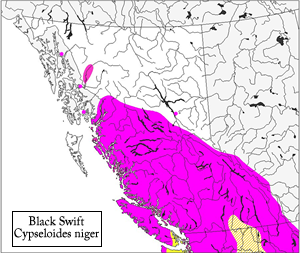The Black Swift is noticeably larger and bulkier than other swift species in British Columbia, and is the only one that is entirely blackish (other species have either paler brown or white on the throat and breast). As a result, this species is relatively unmistakable within B.C.
| This species is not as vocal as other species of swift in B.C., and calls relatively infrequently. It produces bursts of low, flat, twittering or clicking chips, often given in rapid succession and then slowing at the end. Also gives sharp cheet notes when approaching nesting sites at dusk. Source: Sibley (2000); Lowther and Collins (2002); Garrett (2006) |
Courtship
Courtship behaviours essentially unknown, although several observed behaviours are suspected to pertain to the formation of pair bonds. For example, single birds have been observed flying quickly and erratically while being pursued by 3-6 other birds which give a continuous chatter of soft, high-pitched sounds. Similarly, incidents in which one bird pursues another bird at high speeds with erratic flight style are also suspected of referring to the formation of pair bonds.
Nest
Nests are very rarely found anywhere within the species’ breeding range. This species typically nests in loose colonies, likely as a result of the highly localized distribution of suitable nesting sites. It nests exclusively on steep canyon walls and rock cliffs, usually near or behind waterfalls or adjacent to a seepage area that keeps microclimatic conditions humid and cool. Almost nothing known about the process of nest building, although individuals have been observed clinging to vertical cliff faces and gathering moss in their bills. Nest apparently built over a period of ~4 days during late May or early to mid-June, and pairs typically utilize the previous year’s nest when it is available. The nest itself is a small, rounded cup that is composed mostly or entirely of moss, occasionally incorporating minor amounts of other materials such as mud, fern tips, pine needles, small twigs, and (when breeding on coastal cliffs) seaweeds and algae. Most nests are placed on a shallow, sheltered ledge and are protected by an overhanging canopy of mosses or overhanging rock. The nest is 7.5-12.5 cm wide and 2-7.5 cm deep, with an internal cup ~9 cm across. Nests in B.C. have been documented at heights ranging from 3-4.5 m, although elsewhere in its range nests have been observed at heights up to 13.5 m (and likely occur higher on inaccessible cliff faces).
Eggs
The single dull white egg is laid in mid- to late June and is incubated by both sexes for a period of 24-27 days before hatching. Eggs have been observed in B.C. in late June, but are likely present between mid-June and late July or early August. This species is single-brooded.
Young
Nestlings are fully altricial and naked when hatched, with pinkish skin on the belly and bluish-black skin on the upperparts. The young are tended by both parents and remain in the nest for 45-49 days before feldging. The young greatly outgrow the nest by fledging, and just before leaving the nest often cling to the edge of the nest and exercise the wings. Although rarely observed in the province, nestlings apparently occur in B.C. between mid-July and early September.
Source: Campbell et al. (1990b); Baicich and Harrison (1997); Lowther and Collins (2002)
|
Feeds exclusively on flying insects, especially winged ants when they are available. Foraging birds typically feed at very high altitudes above both forests and open habitats, but descend to much lower levels (<200 m) during rainy or cloudy conditions. Usually forages in groups or flocks (sometimes exceeding 100 individuals) during the breeding season and migration, with flocks ranging up to 40 km from nesting sites during feeding forays. Generally pursues insect prey in large arcs, often with a short ascent at the end made by rapid movement of the wings; also sometimes hangs motionless briefly (“stalls”) at the end of this short ascent. Migratory flocks in fall sometimes associate with large flocks of migrating Common Nighthawks to feed on hatches of winged ants over fields, woodlands, and townsites.
Source: Lowther and Collins (2002)
|
|

